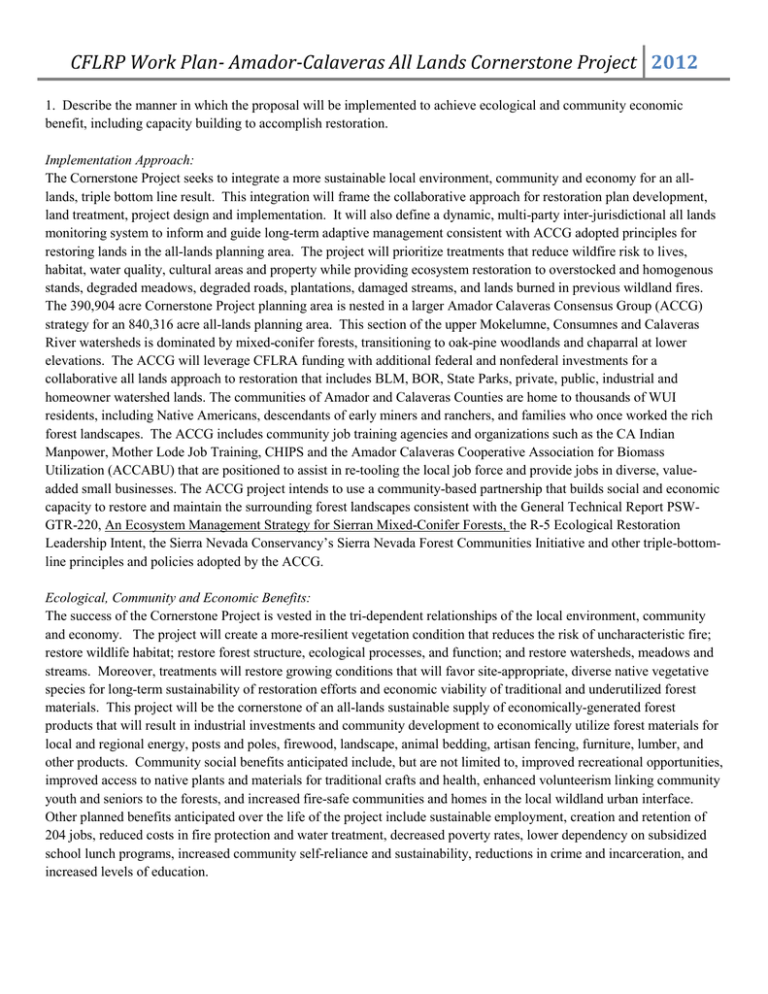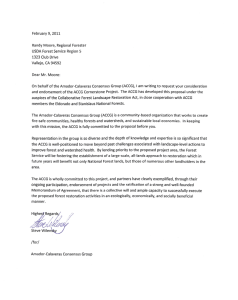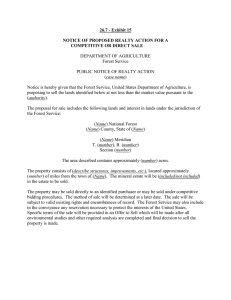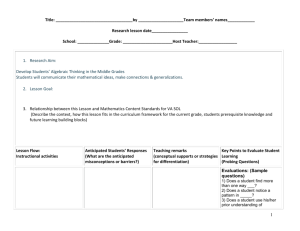CFLRP Work Plan- Amador-Calaveras All Lands Cornerstone Project 2012
advertisement

CFLRP Work Plan- Amador-Calaveras All Lands Cornerstone Project 2012 1. Describe the manner in which the proposal will be implemented to achieve ecological and community economic benefit, including capacity building to accomplish restoration. Implementation Approach: The Cornerstone Project seeks to integrate a more sustainable local environment, community and economy for an alllands, triple bottom line result. This integration will frame the collaborative approach for restoration plan development, land treatment, project design and implementation. It will also define a dynamic, multi-party inter-jurisdictional all lands monitoring system to inform and guide long-term adaptive management consistent with ACCG adopted principles for restoring lands in the all-lands planning area. The project will prioritize treatments that reduce wildfire risk to lives, habitat, water quality, cultural areas and property while providing ecosystem restoration to overstocked and homogenous stands, degraded meadows, degraded roads, plantations, damaged streams, and lands burned in previous wildland fires. The 390,904 acre Cornerstone Project planning area is nested in a larger Amador Calaveras Consensus Group (ACCG) strategy for an 840,316 acre all-lands planning area. This section of the upper Mokelumne, Consumnes and Calaveras River watersheds is dominated by mixed-conifer forests, transitioning to oak-pine woodlands and chaparral at lower elevations. The ACCG will leverage CFLRA funding with additional federal and nonfederal investments for a collaborative all lands approach to restoration that includes BLM, BOR, State Parks, private, public, industrial and homeowner watershed lands. The communities of Amador and Calaveras Counties are home to thousands of WUI residents, including Native Americans, descendants of early miners and ranchers, and families who once worked the rich forest landscapes. The ACCG includes community job training agencies and organizations such as the CA Indian Manpower, Mother Lode Job Training, CHIPS and the Amador Calaveras Cooperative Association for Biomass Utilization (ACCABU) that are positioned to assist in re-tooling the local job force and provide jobs in diverse, valueadded small businesses. The ACCG project intends to use a community-based partnership that builds social and economic capacity to restore and maintain the surrounding forest landscapes consistent with the General Technical Report PSWGTR-220, An Ecosystem Management Strategy for Sierran Mixed-Conifer Forests, the R-5 Ecological Restoration Leadership Intent, the Sierra Nevada Conservancy’s Sierra Nevada Forest Communities Initiative and other triple-bottomline principles and policies adopted by the ACCG. Ecological, Community and Economic Benefits: The success of the Cornerstone Project is vested in the tri-dependent relationships of the local environment, community and economy. The project will create a more-resilient vegetation condition that reduces the risk of uncharacteristic fire; restore wildlife habitat; restore forest structure, ecological processes, and function; and restore watersheds, meadows and streams. Moreover, treatments will restore growing conditions that will favor site-appropriate, diverse native vegetative species for long-term sustainability of restoration efforts and economic viability of traditional and underutilized forest materials. This project will be the cornerstone of an all-lands sustainable supply of economically-generated forest products that will result in industrial investments and community development to economically utilize forest materials for local and regional energy, posts and poles, firewood, landscape, animal bedding, artisan fencing, furniture, lumber, and other products. Community social benefits anticipated include, but are not limited to, improved recreational opportunities, improved access to native plants and materials for traditional crafts and health, enhanced volunteerism linking community youth and seniors to the forests, and increased fire-safe communities and homes in the local wildland urban interface. Other planned benefits anticipated over the life of the project include sustainable employment, creation and retention of 204 jobs, reduced costs in fire protection and water treatment, decreased poverty rates, lower dependency on subsidized school lunch programs, increased community self-reliance and sustainability, reductions in crime and incarceration, and increased levels of education. CFLRP Work Plan- Amador-Calaveras All Lands Cornerstone Project 2012 Restoration Capacity Building: Guided by its principles and adapting from its experience, the ACCG intends to “build the road it travels” toward restoring and maintaining all of the lands in the larger all-lands stewardship planning area. It will design and construct the systems, infrastructure and processes necessary for a sustainable, healthy and functional balance among the environment, community and economy on the 840,316 acre planning area. A focus on a healthy triple bottom line has already inspired local contractors to form the ACCABU, conduct a feasibility study for a product yard and utilization center, and united the community resources of the Mother Lode Job Training Agency, California Indian Manpower, CHIPS, Central Sierra Resource Conservation and Development, community action agencies, local private businesses, Fire Safe Councils, BLM and the USFS to employ trained workers in ecosystem restoration, cultural site protection, timber harvesting, biomass salvaging and woody biomass value-added activities. Continued collaborative and cooperative capacity building activities include increasing access to local qualified NEPA and CEQA professionals to expedite pre-project environmental work, diversifying small businesses for woody biomass value added utilization, developing the Sierra Cascade All Lands Enterprise (SCALE) Demonstration project in cooperation with the Burney Hat Creek CFLRP collaborative project to develop triple bottom line monitoring, adaptive management metrics and best practices. 2. Anticipated unit treatment cost reduction over ten years: Performance Measure Code Average Historic Unit Cost Cost Reduction per Unit FOR-VEG-EST 375 25 FOR-VEG-IMP 250 18 INVPLT-NXWD-FED-AC 423 25 S&W-RSRC-IMP 1500 25 HBT-ENH-LAK 2,156 0 HBT-ENH-STRM 3,077 0 HBT-ENH-TERR 436 0 RG-VEG-IMP 926 0 RD-HC-MAIN RD-PC-MAINT 238 1,348 0 0 RD-DECOM 7,000 700 RD-PCIMP RD-HCIMP 4,675 986 0 0 STRM-CROS-MTG-STD 10,000 2000 TL-MAINT-STD 1,600 320 TL-IMP-STD 18,700 4000 Assumptions Some cost reduction from larger scale contracts Some cost reduction over time from larger scale projects and retreatments Cost savings assumes reduction in treated acres from effective treatments on NFS lands Some cost reduction over time from larger scale projects and maintenance treatments No cost reductions anticipated – repeated treatments No cost reductions anticipated Some cost reduction may occur from reductions in move in/out costs, but cannot anticipate successful bidder(s) Anticipate no cost reduction due to small project size No cost reductions anticipated No cost reductions anticipated Some cost reduction over time from larger scale projects. No cost reductions anticipated No cost reductions anticipated Some cost reduction over time from larger scale projects. Some cost reduction over time from larger scale projects and retreatments Some cost reduction over time from larger scale projects and retreatments CFLRP Work Plan- Amador-Calaveras All Lands Cornerstone Project 2012 Performance Measure Code LND-BLMRK-MAINT Average Historic Unit Cost Cost Reduction per Unit 1,000 100 128 15 TMBR-VOL-SLD 0 0 BIO-NRG 0 0 FP-FUELS-NON-WUI-OUT 256 25 FP-FUELS-NON-WUI-IN 172 10 FP-FUELS-WUI 272 25 TMBR-SALES-TRT-AC SP-INVSPE-FED-AC Assumptions Some cost reduction over time from larger scale projects and retreatments Some cost reduction over time through more effective implementation of GTR-220 No costs – Costs of offering timber volume are captured under Timbrsales-trt-ac No costs – Costs of offering timber volume are captured under Timbrsales-trt-ac Cost savings over time assumes reduction costs associated with 2nd entry retreatments Cost savings over time assumes reduction costs associated with 2nd entry retreatments Cost savings over time assumes reduction costs associated with 2nd entry retreatments No projects in this performance measure 3. Anticipated costs for infrastructure needed to implement project: Type of Infrastructure Anticipated Cost Funding Source (federal, private, etc) 4. Projected sustainability of the supply of woody biomass and small diameter trees removed in ecological restoration treatments: Fiscal Year 2012 2013 2014 2015 2016 2017 2018 2019 Number of acres to be treated 230 800 800 800 800 800 800 800 Projected Green Tons Removed per Acre 15 15 15 15 15 15 15 15 Total Green Tons Available 3,450 12,000 12,000 12,000 12,000 12,000 12,000 12,000 CFLRP Work Plan- Amador-Calaveras All Lands Cornerstone Project 2012 5. Projected local economic benefits: Direct Part and Full-time Jobs 54.9 Total Part and Full-time Jobs 101.5 Other Project Activities 92.2 TOTALS: 147.1 Type of projects Commercial Forest Products Direct Labor Income $2,966,626 Total Labor Income 1 $4,883,207 112.7 $2,612,404 $3,404,566 214.2 $5,579,030 $8,287,773 6. Document the non-Federal investment in the priority landscape: Source of Investment Amount of Investment Description of Use Sierra Nevada Conservancy California State OHV fund Cal. Transportation Enhancement Grant Pacific Gas and Electric California Fish and Game Trout Unlimited Various Range Permittees State of California –Prop 84 and 40 State of California $100,000 $822,000 NEPA Trailhead Improvement Project $404,000 Arnold Rim Trail Improvement Project $766,616 $10,000 $5,000 $363,500 $18,000 $1,035,000 Noxious Weed Treatments Habitat Improvement Habitat Improvement Habitat Improvement Range Management Resource Protection Trail Maintenance and Improvement $25,000 Winton Road Co-op Fuel Break 7. Plans to decommission any temporary roads established to carry out the proposal: 1 Projected accomplishment year (fiscal) Number of Miles to be Decommissioned 2012 2013 2014 2015 2016 2017 2018 2019 2020 2021 0.5 0.5 0.5 0.5 0.5 0.5 0.5 0.5 0.5 0.5 Values obtained from Treatment for Restoration Economic Analysis Tool (TREAT) spreadsheet, “Impacts-Jobs and Income” tab. Spreadsheet available at INSERT WEBSITE HERE






